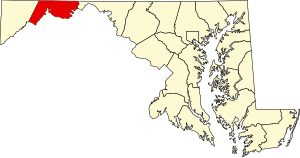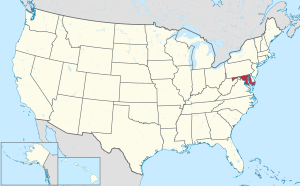Allegany County, Maryland
Allegany County | |
|---|---|
 Location within the U.S. state of Maryland | |
 Maryland's location within the U.S. | |
| Coordinates: 39°38′N 78°41′W / 39.63°N 78.69°W | |
| Country | |
| State | |
| Founded | 1789 |
| Named for | the Allegheny Mountains, which run through the western part of the county |
| Seat | Cumberland |
| Largest city | Cumberland |
| Area | |
| • Total | 429.82 sq mi (1,113.2 km2) |
| • Land | 425.42 sq mi (1,101.8 km2) |
| • Water | 4.40 sq mi (11.4 km2) 1.02% |
| Population | |
| • Estimate (2005) | 73,639 |
| • Density | 180/sq mi (68/km2) |
| Website | gov |
Allegany County is a county located in the northwestern part of the US state of Maryland. It is part of the Cumberland, MD-WV Metropolitan Statistical Area. As of 2000, the population was 74,930. Its county seat is Cumberland. The name Allegany comes from a local Native American word, oolikhanna, which means "beautiful stream."[dubious – discuss] A number of counties in the Appalachian region of the US are named Allegany, Allegheny, or Alleghany.
History
The western part of Maryland (including the present Allegany County) was originally part of Prince George's County when Maryland was formed in 1696.[1] This county included six current counties, and by repeated splitting, new ones were generated: Frederick from Prince George's in 1748;[2] and Montgomery and Washington from Frederick in 1776.[3]
Allegany County was formed in 1789 by the splitting of Washington County.[4] At the time it was the westernmost county in Maryland, but a split in 1872 produced Garrett County, the current westernmost county.[2]
The county has a number of properties on the National Register of Historic Places.[5]
Law and government
Allegany County was granted a home rule form of government in 1974.
Transportation
Geography
According to the 2000 census, the county has a total area of 429.82 square miles (1,113.2 km2), of which 425.42 square miles (1,101.8 km2) (or 98.98%) is land and 4.40 square miles (11.4 km2) (or 1.02%) is water.[6]
Adjacent counties
- Somerset County, Pennsylvania (northwest)
- Bedford County, Pennsylvania (north)
- Fulton County, Pennsylvania (northeast)
- Washington County (east)
- Morgan County, West Virginia (southeast)
- Hampshire County, West Virginia (south)
- Mineral County, West Virginia (southwest)
- Garrett County (west)
See also: List of counties bordering eight counties
National protected areas
Significant Topographic Features
- Evitts Mountain
- Dans Mountain
- Polish Mountain
- Town Hill
- Haystack Mountain
- Martin Mountain
- Wills Mountain
- Piney Mountain
- Green Ridge Mountain
Major highways
 Interstate 68
Interstate 68 U.S. Route 40
U.S. Route 40
 US 40 Alt
US 40 Alt
 U.S. Route 40 Scenic
U.S. Route 40 Scenic U.S. Route 220
U.S. Route 220 Maryland Route 35
Maryland Route 35 Maryland Route 36
Maryland Route 36 Maryland Route 47
Maryland Route 47 Maryland Route 49
Maryland Route 49 Maryland Route 51
Maryland Route 51 Maryland Route 53
Maryland Route 53 Maryland Route 55
Maryland Route 55 Maryland Route 135
Maryland Route 135 Maryland Route 144
Maryland Route 144 Maryland Route 638
Maryland Route 638 Maryland Route 657
Maryland Route 657 Maryland Route 658
Maryland Route 658 Maryland Route 935
Maryland Route 935 Maryland Route 936
Maryland Route 936 Maryland Route 956
Maryland Route 956
Demographics
| Census | Pop. | Note | %± |
|---|---|---|---|
| 1830 | 10,590 | — | |
| 1850 | 22,799 | — | |
| 1900 | 53,694 | — | |
| 1910 | 62,411 | 16.2% | |
| 1920 | 69,938 | 12.1% | |
| 1930 | 79,098 | 13.1% | |
| 1940 | 86,973 | 10.0% | |
| 1950 | 89,556 | 3.0% | |
| 1960 | 84,169 | −6.0% | |
| 1970 | 84,044 | −0.1% | |
| 1980 | 80,548 | −4.2% | |
| 1990 | 74,946 | −7.0% | |
| 2000 | 74,930 | 0.0% | |
| 2010 | 75,087 | 0.2% |
As of the censusTemplate:GR of 2000, there were 74,930 people, 29,322 households, and 18,883 families residing in the county. The population density was 176 people per square mile (68/km²). There were 32,984 housing units at an average density of 78 per square mile (30/km²). The racial makeup of the county was 93.02% White, 5.35% Black or African American, 0.15% Native American, 0.52% Asian, 0.03% Pacific Islander, 0.19% from other races, and 0.75% from two or more races. 0.76% of the population were Hispanic or Latino of any race. 29.0% were of German, 16.7% US or American, 12.8% Irish, 10.7% English and 5.3% Italian ancestry according to Census 2000.[8]
There were 29,322 households out of which 26.50% had children under the age of 18 living with them, 50.60% were married couples living together, 10.30% had a female householder with no husband present, and 35.60% were non-families. 30.10% of all households were made up of individuals and 15.20% had someone living alone who was 65 years of age or older. The average household size was 2.35 and the average family size was 2.90.
In the county the population was spread out with 20.60% under the age of 18, 11.20% from 18 to 24, 26.80% from 25 to 44, 23.50% from 45 to 64, and 17.90% who were 65 years of age or older. The median age was 39 years. For every 100 females there were 99.20 males. For every 100 females age 18 and over, there were 96.90 males.
The median income for a household in the county was $30,821, and the median income for a family was $39,886. Males had a median income of $31,316 versus $21,334 for females. The per capita income for the county was $16,780. About 9.70% of families and 14.80% of the population were below the poverty line, including 17.70% of those under age 18 and 9.50% of those age 65 or over.
As of 2010, Allegany County had a racial and ethnic population composition of 88.16% Non-Hispanic whites, 8.03% Blacks, 0.14% Native Americans, 0.76% Asians, 0.04% Pacific Islanders, 0.08% Non-Hispanics who reported some other race, 1.47% Non-Hispanics who reported two or more races and 1.44% Hispanics.
Cities and towns

This county contains the following seven incorporated municipalities:
- Two cities:
- Cumberland (incorporated 1815)
- Frostburg (incorporated 1839)
- Five towns:
- Barton (incorporated 1900)
- Lonaconing (incorporated 1890)
- Luke (incorporated 1922)
- Midland (incorporated 1900)
- Westernport (incorporated 1858)
Occupying a middle ground between incorporated and unincorporated areas are Special Tax Districts, quasi-municipal unincorporated areas created by legislation passed by the Maryland General Assembly.[1] They lack home rule authority and must petition the General Assembly for changes affecting the authority of the district. There are eight Special Tax Districts in the county:
- Bel Air (1965)
- Bowling Green and Robert's Place (1972)
- Cresaptown (1949)
- Ellerslie (1963)
- La Vale Sanitary District (1947)
- McCoole (1965)
- Mount Savage (1950)
- Potomac Park Addition (1947)
Unincorporated areas are also considered as towns by many people and listed in many collections of towns, but they lack local government. Various organizations, such as the United States Census Bureau, the United States Postal Service, and local chambers of commerce, define the communities they wish to recognize differently, and since they are not incorporated, their boundaries have no official status outside the organizations in question. The Census Bureau recognizes the following census-designated places in the county:
- Cresaptown-Bel Air (a combination of the communities of Cresaptown and Bel Air recognized as a unit by the Census Bureau)
- La Vale
Other unincorporated areas include:
- Amcelle
- Barrelville
- Bier
- Borden Shaft
- Carlos
- Clarysville
- Corriganville
- Danville
- Dawson
- Detmold
- Dickens
- Eckhart Mines
- Evitts Creek
- Flintstone
- George's Creek
- Gilmore
- Klondike
- Little Orleans
- Loartown
- Midlothian
- McKenzie
- Moscow
- Mount Savage
- Narrows Park
- Nikep
- Oldtown
- Pekin
- Pinto
- Rawlings
- Shaft
- Spring Gap
- Town Creek
- Vale Summit
- Woodland
- Zihlman
Government and infrastructure
The North Branch Correctional Institution, operated by the Maryland Department of Public Safety and Correctional Services, is located in unincorporated Allegany County, near Cumberland.[9] The prison began housing male death row inmates, who were moved from the Maryland Correctional Adjustment Center, in June 2010.[10]
Colleges and universities
Notable residents
- Thomas Cresap (c. 1702–c. 1790), frontiersman and militia leader, who founded Oldtown and widened Nemacolin's Trail, which led west from Cumberland.
- Michael Cresap (1742–1775), born in Allegany County, American Revolutionary War officer.[11]
- Patrick Hamill (1817–1895), born in Allegany County, United States Congressman from Maryland.[11]
- Lloyd Lowndes former Governor of Maryland.
- Lefty Grove (1900–1975), born and raised in Lonaconing; Hall of Fame baseball pitcher with the Philadelphia Athletics and Boston Red Sox.
- William H. Macy (1950–), an Emmy Award-winning and Academy Award-nominated American actor, known for his role as Jerry Lundegaard in Fargo. He attended Allegany High School. His mother and brother continue to live in Cumberland, where he is a frequent visitor.
- Sam Perlozzo, former manager of the Baltimore Orioles (2005–2007).
- Leo Mazzone, former pitching coach of the Baltimore Orioles and the Atlanta Braves.
- Casper R. Taylor, Jr., former Speaker of the House in the Maryland House of Delegates.
- Aaron Laffey, MLB pitcher with the Seattle Mariners.
Mountains
The following Mountains are in Allegany County:
- Breakneck Hill (1,872 ft)
- Collier Mountain (1,460 ft)
- Dans Mountain (2,898 ft)
- Evitts Mountain (1,959–2,260 ft.)
- Martin Mountain (1,974 ft)
- Nicholas Mountain (1,760 ft)
- Polish Mountain (1,783 ft)
- Ragged Mountain (1,740 ft)
- Town Hill (2,039 ft)
- Warrior Mountain (2,185 ft)
- Wills Mountain (1,960+ ft.)
- Haystack Mountain (1,240+ ft.)
- Irons Mountain
Mineral Resources
The primary mineral resources extracted for use in Allegany County are coal, iron, sandstone, and limestone. Coal bearing formations are concentrated in the Georges Creek Basin in the western part of the county.
See also
References
- ^ Thomas, James W. and Williams, Thomas J.C. History of Allegany County, Maryland. Baltimore, Md.: Regional Publishing Co., 1969, p. 289.
- ^ a b Bentley, Elizabeth Petty. County Courthouse Book. Baltimore, Md.: Genealogical Publishing Co., 2009, p. 128.
- ^ Bentley, Elizabeth Petty. County Courthouse Book. Baltimore, Md.: Genealogical Publishing Co., 2009, p. 129.
- ^ Bentley, Elizabeth Petty. County Courthouse Book. Baltimore, Md.: Genealogical Publishing Co., 2009, p. 126.
- ^ "National Register Information System". National Register of Historic Places. National Park Service. April 15, 2008.
- ^ "Census 2000 U.S. Gazetteer Files: Counties". United States Census. Retrieved 2011-02-13.
- ^ "Population of Counties by Decennial Census: 1900 to 1990". U.S. Census Bureau. Retrieved 2007-04-20.
- ^ The last five National Origin figures are taken from the Long Form, which was given to less than 20% of respondents but then extrapolated to the whole. Besides this problem in making a comparison, the long form also limits people to only two stated ancestries, but unlike racial counts, if someone states two ancestries they are counted in both, while in racial counts they are grouped as "some other race."
- ^ "North Branch Correctional Institution." North Branch Correctional Institution. Retrieved on September 22, 2010.
- ^ Calvert, Scott and Kate Smith. "Death row inmates transferred to W. Maryland." The Baltimore Sun. June 25, 2010. Retrieved on September 22, 2010.
- ^ a b Who Was Who in America, Historical Volume, 1607–1896. Chicago: Marquis Who's Who. 1963.

